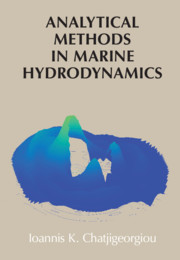Book contents
- Analytical Methods in Marine Hydrodynamics
- Dedication
- Analytical Methods in Marine Hydrodynamics
- Copyright page
- Contents
- Foreword
- Preface
- Note on Symbols and Notations
- 1 Description of the Flow
- 2 Linear Hydrodynamics of Circular Cylinders
- 3 Higher-Order Phenomena for Circular Cylinders
- 4 Hydrodynamics of Elliptical Cylinders
- 5 Hydrodynamics of Spheres and Spheroids
- 6 Hydrodynamics of Ellipsoids
- Book part
- References
- Index
5 - Hydrodynamics of Spheres and Spheroids
Published online by Cambridge University Press: 27 June 2018
- Analytical Methods in Marine Hydrodynamics
- Dedication
- Analytical Methods in Marine Hydrodynamics
- Copyright page
- Contents
- Foreword
- Preface
- Note on Symbols and Notations
- 1 Description of the Flow
- 2 Linear Hydrodynamics of Circular Cylinders
- 3 Higher-Order Phenomena for Circular Cylinders
- 4 Hydrodynamics of Elliptical Cylinders
- 5 Hydrodynamics of Spheres and Spheroids
- 6 Hydrodynamics of Ellipsoids
- Book part
- References
- Index
Summary
Spheres and spheroids are axisymmetric bodies in the sense that their geometry is achieved by revolution of a curve around the axis of symmetry. It is usually said that the sphere is the simplest geometry given that it has three axes of symmetry. Each of the axes of the Cartesian system fixed on the center of a sphere is actually an axis of symmetry. Spheroids, on the other hand, have a single symmetrical axis and are distinguished as “oblate” and “prolate” spheroids. The former are sometimes called “squashed” spheroids for which the equatorial radius is greater than the polar radius. In contrast, in a prolate spheroid, also called a “pointy” spheroid, the polar radius is greater than the equatorial radius. The term “ellipsoid,” which is often used by authors to describe spheroids, is erroneous and misleading given that an ellipsoid is not a symmetric geometry while a spheroid is a special case of the ellipsoid when two of its semiaxes are equal.
Spheres and spheroids may have several practical applications in hydrodynamics, say as buoyancy elements, remote or autonomously operating vehicles, components of wave energy converters, especially for spheres. Prolate spheroids in particular may approximate to a major extent the geometry of submarines. Much attention was given to the hydrodynamic analyses of those geometries in the early twentieth century by pioneer hydrodynamicists, among whom it is easy to highlight the name of Sir Thomas Havelock. It was the time when everything had to be done by putting “pen onto paper” and not “fingers onto keyboard.” The lack of computation tools led, unavoidably, to comprehensive mathematical elaboration providing in addition better insight to the use and the properties of spherical and spheroidal harmonics. The hydrodynamical studies in spherical and spheroidal geometries were boosted significantly after Fritz Ursell and his method of multipoles. This method, also referred to as Ursell’s multipoles, allowed the proper construction, using the governing the Green’s function, of the velocity potentials associated with individual boundary value problems.
In the present chapter we aim to consolidate and describe the current state of the art in analytical methods that treat various hydrodynamic boundary value problems involving spheres and spheroids. All problems are tackled by the method of multipole expansions, which is extensively outlined and analyzed. Again, by definition, the problems are set in the Laplace domain in spherical and spheroidal coordinate systems. The proper Green’s functions are provided and are elaborated to be transformed into multipole expansions, that is, expansions of the governing harmonics. For the spheroidal geometries considered, two types of conditions are established, as required, by the orientation of the axis of symmetry relative to the position of the free surface. These conditions are coined as axisymmetric and “nonaxisymmetric” depending on whether the symmetrical axis is perpendicular or parallel to the free surface. It should be mentioned that that simple rotation causes major complications in the formulations. Also, special attention is given to the Lagally theorem and its generalizations for unsteady flows. This theorem allows substantial easiness in the computation of the hydrodynamic loading compared to cumbersome and, eventually, complicated method of the direct pressure integration.
- Type
- Chapter
- Information
- Analytical Methods in Marine Hydrodynamics , pp. 238 - 333Publisher: Cambridge University PressPrint publication year: 2018



